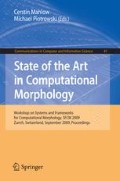Abstract
JSLIM is a software system for writing grammars in accordance with the SLIM theory of language. Written in Java, it is designed to facilitate the coding of grammars for morphology as well as for syntax and semantics. This paper describes the system with a focus on morphology. We show how the system works, the evolution from previous versions, and how the rules for word form recognition can be used also for word form generation. The first section starts with a basic description of the functionality of a Left Associative Grammar (LAG) and provides an algebraic definition of a JSLIM grammar. The second section deals with the new concepts of JSLIM in comparison with earlier implementations. The third section describes the format of the grammar files, i.e. of the lexicon, of the rules and of the variables. The fourth section broaches the subject of the reversibility of grammar rules with the aim of an automatic word form production without any additional rule system. We conclude with an outlook on current and future developments.
Access this chapter
Tax calculation will be finalised at checkout
Purchases are for personal use only
Preview
Unable to display preview. Download preview PDF.
References
Hausser, R.: A Computational Model of Natural Language Communication: Interpretation, Inference, and Production in Database Semantics. Springer, Heidelberg (2006)
Hausser, R.: Foundations of Computational Linguistics. Springer, Heidelberg (1999)
Hausser, R.: Complexity in left-associative grammar. Theoretical Computer Science 106, 283–308 (1992)
Beutel, B.: Malaga 7.12. User’s and Programmer’s Manual. Technical report, Friedrich-Alexander-Universität Erlangen-Nürnberg (1995), http://home.arcor.de/bjoern-beutel/malaga/malaga.pdf (June 4, 2009)
Kycia, A.: Implementierung der Datenbanksemantik für die natürlichsprachliche Kommunikation. Master’s thesis, Friedrich-Alexander-Universität Erlangen-Nürnberg (2004)
Wittgenstein, L.: Philosophical Investigations. Basil Blackwell Ltd., Oxford (1953)
Handl, J.: Entwicklung einer abstrakten Maschine zum Parsen von natürlicher Sprache. Master’s thesis, Friedrich-Alexander-Universität Erlangen-Nürnberg (2008)
Schulze, M.: Ein sprachunabhängiger Ansatz zur Entwicklung deklarativer, robuster LA-Grammatiken mit einer exemplarischen Anwendung auf das Deutsche und das Englische. PhD thesis, Friedrich-Alexander-Universität Erlangen-Nürnberg (2004)
Kapfer, J.: Inkrementelles und oberflächenkompositionales Parsen von Koordinationselipsen. PhD thesis, Friedrich-Alexander-Universität Erlangen-Nürnberg (2009)
Schüller, G., Lorenz, O.: LA-Morph - Ein linksassoziatives Morphologiesystem. In: Linguistische Verifikation, pp. 103–119 (1994)
Weber, C.: Implementierung eines automatischen Wortformerkennungssystems für das Italienische mit dem Programm JSLIM. Master’s thesis, Friedrich-Alexander-Universität Erlangen-Nürnberg (2007)
Weber, C., Handl, J., Kabashi, B., Proisl, T.: Eine erste Morphologie in JSLIM (in progress). Technical report, Friedrich-Alexander-Universität Erlangen-Nürnberg (2009), http://www.linguistik.uni-erlangen.de/clue/fileadmin/docs/jslim/morphology_docu.pdf (June 4, 2009)
Lorenz, O.: Automatische Wortformenerkennung für das Deutsche im Rahmen von Malaga. Master’s thesis, Friedrich-Alexander-Universität Erlangen-Nürnberg (1996)
Hausser, R.: Modeling natural language communication in database semantics. In: Proceedings of the APCCM, vol. 96, Australian Computer Science Inc. CIPRIT (2009)
Kabashi, B.: Sprachproduktion im Rahmen der SLIM-Sprachtheorie. PhD thesis, Friedrich-Alexander-Universität Erlangen-Nürnberg (in progress, presumably 2009)
Author information
Authors and Affiliations
Editor information
Editors and Affiliations
Rights and permissions
Copyright information
© 2009 Springer-Verlag Berlin Heidelberg
About this paper
Cite this paper
Handl, J., Kabashi, B., Proisl, T., Weber, C. (2009). JSLIM – Computational Morphology in the Framework of the SLIM Theory of Language. In: Mahlow, C., Piotrowski, M. (eds) State of the Art in Computational Morphology. SFCM 2009. Communications in Computer and Information Science, vol 41. Springer, Berlin, Heidelberg. https://doi.org/10.1007/978-3-642-04131-0_2
Download citation
DOI: https://doi.org/10.1007/978-3-642-04131-0_2
Publisher Name: Springer, Berlin, Heidelberg
Print ISBN: 978-3-642-04130-3
Online ISBN: 978-3-642-04131-0
eBook Packages: Computer ScienceComputer Science (R0)

